Tucked away in southeastern Sicily, Scicli has gone from being a quiet baroque treasure to a surprising television star. I first stumbled across this enchanting town while wandering through Sicily’s “Val di Noto” region, where baroque architecture dominates the scenery.
What sets Scicli apart? Its real streets and buildings have become the perfect set for the beloved Italian TV series “Commissario Montalbano,” turning it into the fictional “Vigata” that millions adore.
When you walk through Scicli, you feel like you’ve wandered onto a movie set—except it’s been this way for centuries. The town hall square, grand palazzos, and winding stone lanes create a vibe that directors dream about.
Filmmakers keep coming back to capture that magic. Even beyond Montalbano, the nearby Castello di Donnafugata has appeared in classics like “Il Gattopardo.” This whole area feels like a playground for film lovers.
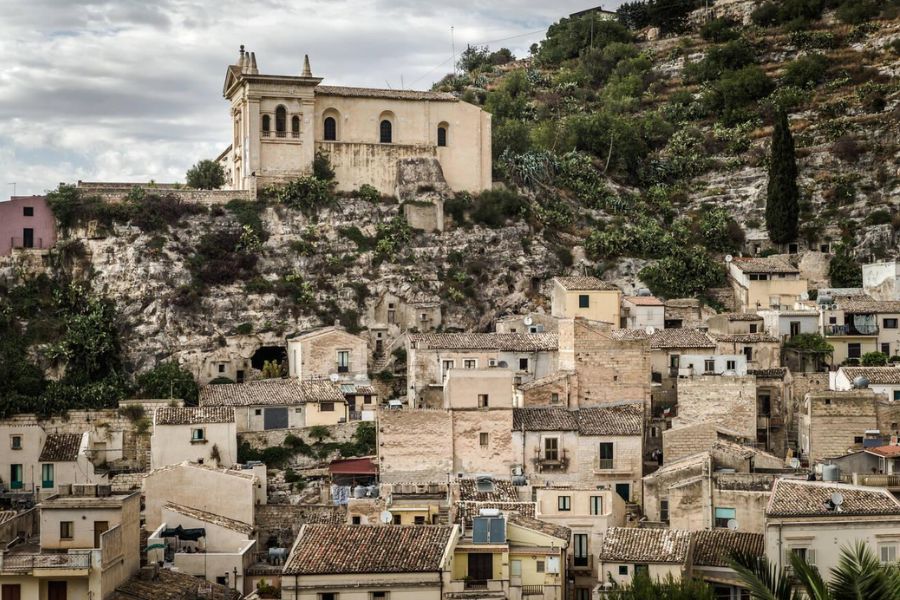
Honestly, my favorite thing was just wandering the almost car-free streets, picturing scenes from the show and soaking up the baroque details everywhere. The town even has its own little legend—Italo, a stray dog who won everyone’s hearts and became part of Scicli’s story.
If you love history and TV, this place is a perfect mix.
Scicli: The Baroque Jewel of Sicily
Scicli sits in southeastern Sicily, charming visitors with its baroque architecture and deep cultural roots. It’s just 25 kilometers from Ragusa, nestled in a valley that shows off Sicily’s historic beauty.
UNESCO World Heritage Status
I was honestly surprised to learn that Scicli is a UNESCO World Heritage site. It got this honor as part of the “Late Baroque Towns of the Val di Noto.” The town, like others nearby, had to rebuild after the massive 1693 earthquake.
Wandering here feels like stepping into a living museum. Thanks to UNESCO, Scicli keeps its unique look and historical feel intact.
This place doesn’t just preserve buildings; it preserves a whole movement of rebuilding and rebirth.

Scicli stands alongside Ragusa, Modica, and Noto—each one telling a piece of Sicily’s comeback story after disaster.
Historical Baroque Architecture
Scicli’s baroque style rose from tragedy. The 1693 earthquake wiped out most of the medieval town, so architects rebuilt it with bold baroque flair.
Some of the town’s standout features:
- Ornate balconies with delicate ironwork
- Dramatic facades full of carved stone details
- Curved buildings that follow the valley’s shape
- Honey-colored limestone that glows at sunset
What really struck me? The way the baroque architecture blends right into the landscape. Buildings seem to tumble down the hillsides, making the whole place feel like a stage set.
Walk down Via Francesco Mormino Penna, the main street, and you’ll see palazzos lined up, each with its own personality. The craftsmanship from the 1700s is everywhere.
Duomo di San Giorgio and Iconic Churches
The Duomo di San Giorgio stands out as Scicli’s crown jewel. Its grand facade and sweeping staircase pull you in. Inside, you’ll find art and baroque details that are just so Sicilian.
Scicli has more than one beautiful church, though. Some you shouldn’t miss:
- Chiesa di San Bartolomeo
- Chiesa di Santa Maria la Nova
- Chiesa di San Giovanni Evangelista
Each church has its own quirks and treasures. The interiors are filled with altars, frescoes, and sculptures that speak to Sicily’s deep Catholic roots.
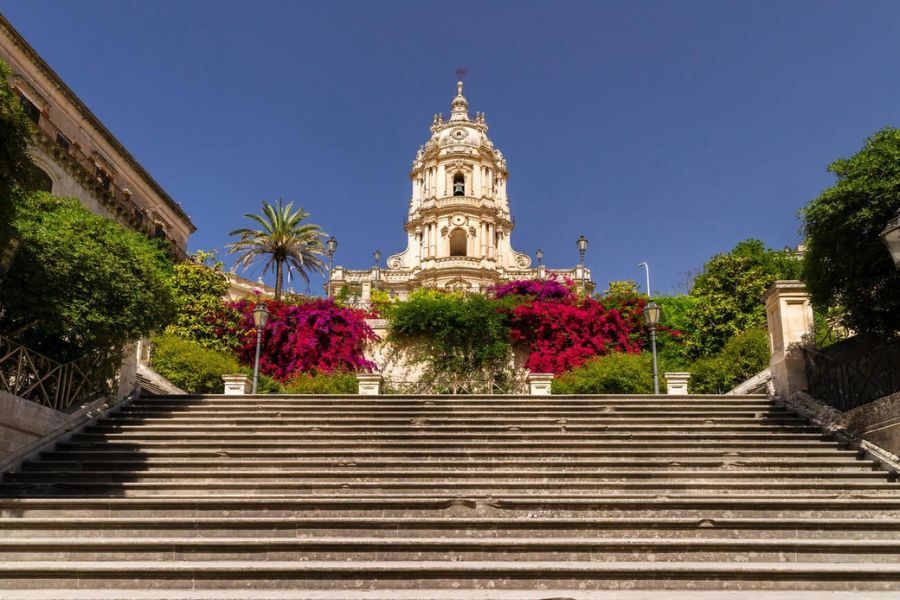
What I love is how these churches fit right into the town. Some rise from tight little streets, others perch on hills, making striking silhouettes against the sky. They’re not just places to pray—they’re part of daily life here.
From Quiet Town to Television Stardom
Scicli changed almost overnight from a sleepy baroque town to a hot filming location. TV producers spotted its ancient streets and sun-baked piazzas and knew they’d found gold.
Inspector Montalbano: The Series
I actually first saw Scicli while watching “Inspector Montalbano” on BBC Four. This Italian crime drama, based on Andrea Camilleri’s books, made the town famous. The show follows detective Salvo Montalbano, played by Luca Zingaretti, as he solves crimes in this part of Sicily.
A lot of fans don’t realize that Scicli’s town hall is the Vigàta police station in the show. Standing there, I couldn’t help but picture all those scenes.
The series started in 1999 and quickly won fans in Italy and beyond. These days, signs point out “Montalbano filming locations” and you can find detective souvenirs in local shops.
Vigàta and Montelusa: Fictional Settings
Vigàta and Montelusa aren’t real places, but Scicli and nearby towns bring them to life. Camilleri based them on his own hometown, Porto Empedocle, and Agrigento.
Scicli’s town hall on Via Francesco Mormino Penna becomes Vigàta’s police station. I spent ages just soaking up the baroque details and picturing Montalbano dashing up those stairs.

Other spots like Ragusa Ibla and Modica also show up as parts of Montelusa. The coastline near Punta Secca, where Montalbano’s beach house sits, has become a must-see for fans.
The Impact of Italian TV on Scicli
Before Montalbano, hardly any tourists came here. Now, getting a table at Trattoria da Daisy (named after a spot in the show) without a booking feels impossible.
Tourism has exploded—up more than 300% since the show aired. Locals have run with it, naming shops and restaurants after the detective.
This wave of visitors has helped save Scicli’s old buildings. Restorations keep the town looking perfect for filming. The town even received UNESCO World Heritage status in 2002, partly thanks to the show’s spotlight.
Italian TV has put Scicli on the map. Now it’s a must for both film fans and anyone searching for real Sicilian baroque.
Montalbano Filming Locations in and Around Scicli
Inspector Montalbano’s fictional Vigata comes alive mostly in Scicli, where so many memorable scenes were shot. The baroque streets and sunlight make the perfect setting for the detective’s adventures.
Circolo di Conversazione and Other Landmarks
As I wandered Scicli, I spotted several key Montalbano locations right away. The biggest one? The Scicli Municipal Town Hall, which stands in for Vigata’s police station. Fans everywhere recognize that facade.
The Circolo di Conversazione, a 19th-century gentlemen’s club, pops up in multiple episodes. With its vintage decor, it really transports you back in time.
Other local landmarks from the show include:
- The Church of San Matteo, perched above the town
- Via Francesco Mormina Penna, the main street
- Palazzo Beneventano, famous for its quirky faces
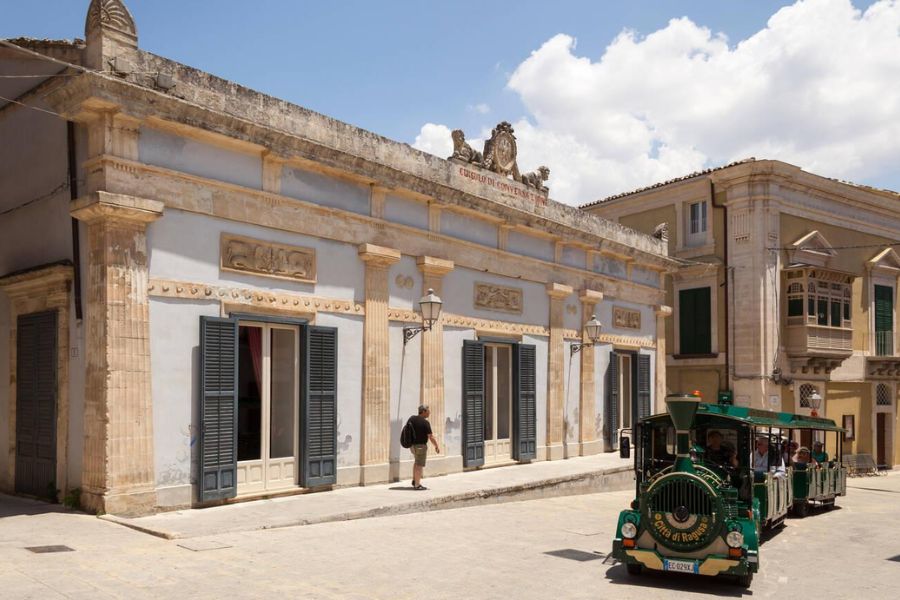
Modica, Ragusa Ibla, and Baroque Neighbors
Montalbano filming locations stretch beyond Scicli. Ragusa Ibla, with its winding alleys and the grand Duomo of San Giorgio, often stands in for Montelusa.
Modica blew me away when I visited. Just 20 minutes from Scicli, this town is famous for chocolate, steep staircases, and churches on hilltops—perfect for dramatic TV scenes.
These towns, along with Noto and Scicli, form the Val di Noto UNESCO site. If you love baroque architecture, this is the place to be.
Punta Secca and Marinella Beach Houses
You can’t do a Montalbano tour without seeing Punta Secca, the real-life Marinella. I stood right outside Montalbano’s beach house, picturing him gazing out at the sea.
The house is actually private property now, but fans flock here anyway. Nearby, you can eat at the same spot where Montalbano enjoys his seafood.
The golden beaches and clear water along this coast show up in some of the show’s most memorable scenes. I loved sitting here at sunset, half-expecting to see the inspector stroll by.
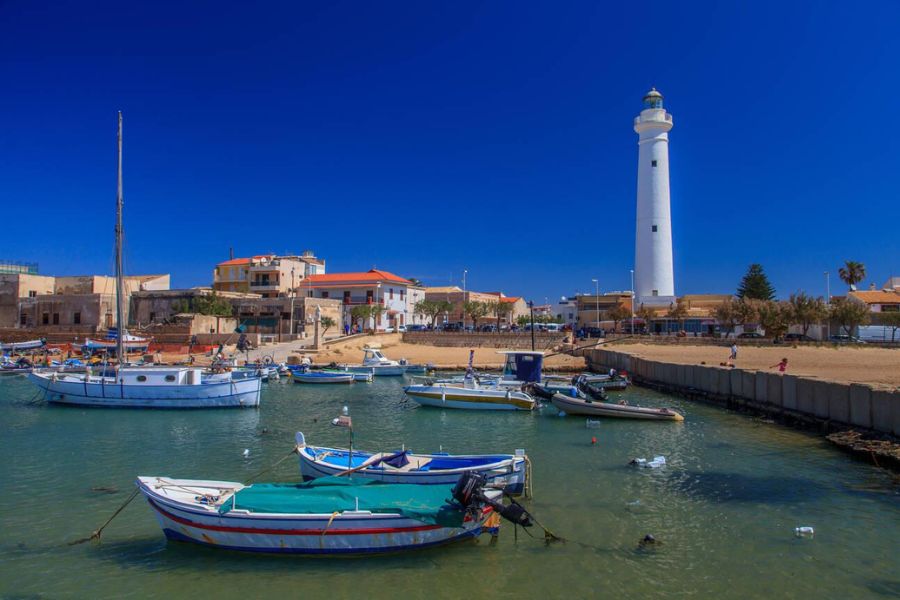
Plenty of tour companies now offer day trips to all the main Montalbano spots.
Behind the Scenes: From Page to Screen
Montalbano’s journey from book to TV is one of Italy’s biggest literary success stories. The show brought Sicily’s baroque towns and coastlines to viewers everywhere.
Andrea Camilleri and the Montalbano Novels
I found Andrea Camilleri’s books while exploring Sicily’s literary scene. Born in Porto Empedocle in 1925, Camilleri didn’t find fame until his late sixties—then he created Inspector Salvo Montalbano. He even named the character after Spanish writer Manuel Vázquez Montalbán.
These novels stand out for their use of Sicilian dialect and their mouthwatering descriptions of food, culture, and scenery. Camilleri based Vigàta on his own town.
When the books hit TV in 1999, they became a phenomenon. The series kept Camilleri’s sharp social commentary and the detective’s love of seafood and swimming.
The Role of Luca Zingaretti
Luca Zingaretti really brings Montalbano to life. I’ve watched how he mixes thoughtfulness with flashes of Sicilian fire, making the character feel real.
He doesn’t look exactly like the book version—he’s taller and more imposing—but he nails the detective’s spirit.
Zingaretti’s Montalbano loves food; those scenes at Enzo’s trattoria almost feel like meditation. He also shows the detective’s strong moral code and complicated feelings about Sicily.
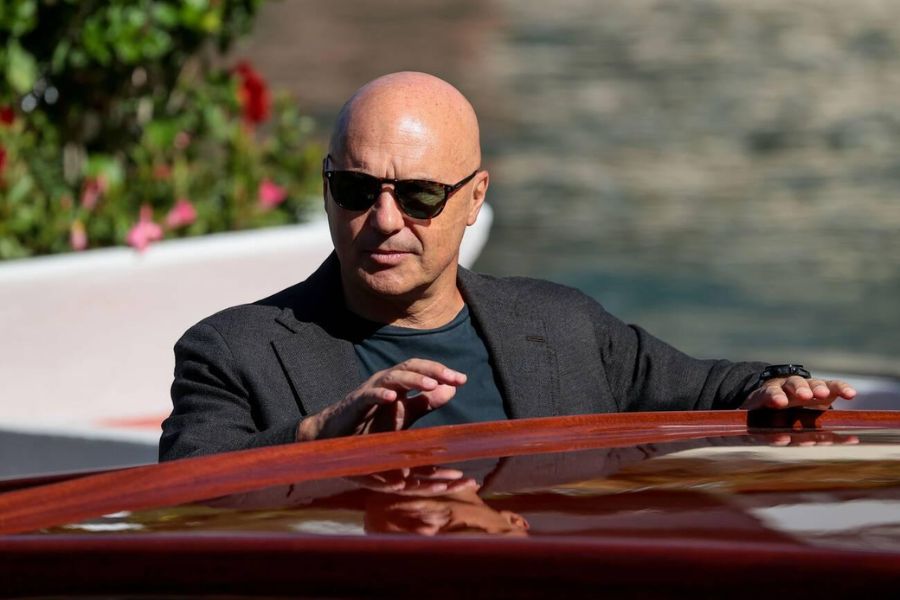
He learned the Sicilian accent for the role and even does many of his own stunts, including the famous swimming scenes.
Real-Life Inspirations: Porto Empedocle and Vigàta
Walking around Porto Empedocle, I felt like I was inside Camilleri’s head. The town even added “Vigàta” to its official name for a while.
For the TV show, the crew chose Sicily’s southeastern baroque towns for filming. Scicli became Vigàta’s police station, Ragusa Ibla stood in for other parts, and Punta Secca’s beach house turned into Montalbano’s iconic home.
I found it fascinating how the crew stitched together real places to create a believable fictional world. They picked spots that matched Camilleri’s writing but also showed off Sicily’s baroque beauty.
Locals often appear as extras, adding real Sicilian flavor to the scenes. Even the stray dog Italo, who sometimes pops up in the series, became a fan favorite.
Experiencing Scicli: Travel Tips and Local Culture
Visiting Scicli brings together a bit of movie magic and real Sicilian experiences. The town feels welcoming, making it easy to dive into local traditions while soaking up the baroque atmosphere and nearby sights.
Culinary Delights: Arancini and Local Flavors
Scicli’s food scene pulled me in just as fast as the architecture did. Arancini—those golden, crispy rice balls—became a quick favorite. I stumbled across the best ones at tiny, family-run cafés hidden away from the main squares.
If you want a real taste of Sicily, try the trattorie around Via Mormino Penna. The seafood pasta there really lets you feel the coastal vibe of Sicilian cooking. And the ricotta-filled cannoli? They’re nothing like the ones you get in the States—crisp shells, never soggy, and they fill them right when you order.
If you’re lucky enough to visit during festival season, food gets even more interesting. The annual chocolate festival in Modica (just a short 15-minute drive) blew my mind with its grainy, dark chocolate. Honestly, I didn’t expect to like it so much, but the old Spanish recipe just works.

Local wine bars pour Nero d’Avola and other Sicilian wines, and the prices are better than you’d think. With your glass, you’ll usually get a plate of olives, cheese, and bread—simple but perfect.
Exploring Nearby Towns: Noto and Agrigento
Noto sits just 40 minutes from Scicli and those honey-colored limestone buildings really shine in the afternoon sun. People call it the perfect Baroque town, and I have to agree. The wide streets and elegant churches make for a pretty magical day trip. I liked hanging out on the Noto Cathedral’s grand staircase—great spot for people-watching.
Agrigento’s Valley of the Temples honestly left me speechless. You stand there, looking at these ancient Greek temples, and it’s hard not to feel a bit awed. The ruins rise up against the sky and the Mediterranean, and you’ll want at least half a day to wander around this UNESCO site.
Summer brings crowds to both towns, so I started exploring early in the morning—before 10 AM. That way, you get fewer tourists and softer light for photos.
Public transportation can get you to these towns, but I rented a car instead. Having my own wheels meant I could stop at tiny villages and random viewpoints along the coast. Most people skip Palazzolo Acreide, but it’s a baroque gem with way fewer tourists.
Day Trips: Castello di Donnafugata and Mount Etna
Castello di Donnafugata isn’t really a medieval castle. It’s more of a grand noble residence, and fans of Montalbano will recognize it right away. Just 20 minutes from Scicli, the place mixes up different architectural styles and has sprawling gardens. I spent ages in the stone maze—it’s smaller than you’d think, but still a lot of fun.
Mount Etna takes a bit more effort, but it’s absolutely worth it. The drive is about 2.5 hours, so get ready for a long day. But come on—Europe’s most active volcano? The views and hiking can’t be matched. You can even take cable cars and 4×4 buses up to 2,900 meters.
If you’re heading there in winter, check the conditions first. I didn’t expect to find skiing on Etna, but from December through February, it’s totally possible. Sicily’s beaches and a volcano with snow—kind of wild, right?

Tour companies in Scicli set up packages that handle transport and guides for both spots. I’d suggest booking at least two days ahead if you’re going during peak season.
Getting the Best Images of Scicli
If you want postcard-perfect photos of Scicli, get up early. That soft morning light just pours over the baroque facades, turning everything gold.
You’ll catch a breathtaking panorama from San Matteo Church. Those terracotta rooftops set against the limestone cliffs? Unforgettable.
By midday, sunlight slices through the narrow streets and throws wild shadow patterns everywhere. I noticed Via Francesco Mormino Penna—the one from Montalbano—looks especially photogenic around 4pm, when the light finally chills out.
If you’re into photography, check out the town hall. It pops up as the Vigàta police station in the series, and you can actually go inside some areas.
You can use tripods outdoors, but double-check before setting one up inside. They’re a bit stricter about that.
Honestly, my favorite photos didn’t come from the big sights. I got them just wandering the quieter residential streets, far from the tourist crowds.
There’s something about laundry strung between balconies, old folks chatting on their stoops, and the faded wooden doors. Those little moments felt more real than anything else.

